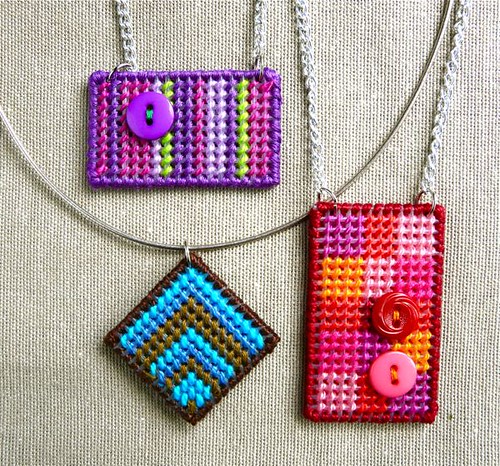How to Make a Needlepoint Pendant (Yes! With Plastic Canvas!)
I get thousands of emails each week, begging me to offer more plastic canvas coverage on this blog.
(…Okay, well – perhaps that actually happens only in my mind. But still.)
I’ve been noodling with these needlepoint pendants lately, and liking both the process and finished product. They make up quickly, and use up odds and ends of embroidery floss. Plastic canvas makes a great base for these, because it adds a “heft” that helps the pieces drape well.
Also, it’s plastic canvas.
But not just any old plastic canvas!
I used 10-count PC for this project, which is a different animal from the bigger 7-count stuff you usually see at your local craft store. (In the photo above, it’s the stuff in the center. The “count” refers to the number of squares per inch, by the way.) 10-count has a finer finish, which takes very nicely to six-strand or pearl cotton embroidery floss.
If you can’t find 10-count canvas locally, you can get it online. It’s great stuff! (If you’re curious, the canvas on the right is 14-count. I’ve made little gift boxes with it.)
…So, to begin your pendant, cut two same-size pieces of canvas. You can make them any size and shape you like. You may have a specific needlepoint design in mind – and in that case, you’d want to count the number of squares you’ll need as you’re cutting the canvas.
Or, you can take my patented lazy approach, and just cut a shape and figure out the needlepoint later.
Then, stitch both pieces. I like to stitch them differently, so my pendants are reversible, but you can also make them identical. I’m using a crewel needle here, because it fits nicely through the canvas holes, and a single strand of pearl cotton. If you’re using six-strand floss, just use all six strands.
I’m using good old Continental stitch and just playing with colors, but remember – there are so many interesting needlepoint stitches in the world! These are tiny blank canvases – so have fun!
(Incidentally, if you want to sew buttons or sequins to your pendant, this is the time to do that, too.)
Now, we’ll stitch the two pieces together. Place them so the right sides are facing out. Thread your needle with a double strand of floss – it provides better coverage at the edges than a single strand.
Pass the needle up through the top layer of canvas only, as shown.
Pull the needle through until you have about 1″ of floss. Lay this between the two pieces of canvas, as shown. Then take your next stitch by passing the needle up through both layers of canvas together.
Repeat this stitch to cover the edges of the canvas. (It’s called a whip stitch, by the way.) As you stitch, catch that tail of floss in your stitches, as shown here.
Stitch your way around the pendant. To fully cover each corner, take three stitches in the corner hole.
When you’ve stitched all the way around the pendant, it’s time to finish off your floss. To do this, pass your needle carefully between the two layers of canvas, and back out the side, as shown here.
Use a pair of needle-nose pliers to pull the needle and floss through. Seriously, you’ll need the pliers. Unless you possess super-human strength.
Clip the excess floss close to the edge of the pendant.
Get a nice, big jump ring, like a 7mm or 8mm. This is the proper way to open a jump ring – you twist it open a bit.
Carefully feed the jump ring through the canvas – pliers are helpful here, too.
If you want your pendant attached to a chain, you can also feed the chain link onto the jump ring now.
Then, close the jump ring. (Here’s how, if you aren’t familiar.)
…And you’re done!
I’m thinking these have some interesting mixed-media possibilities, because you can add buttons and beads easily, or embroider on top of the needlepoint. You could even applique some fabric over the needlepoint. Heck, you could even try stamping or painting over it.
If you make one of these, I’d love to add a photo of it to the CraftyPod Flickr group! Just email me or comment here, won’t you?
How to Make a Needlepoint Pendant (Yes! With Plastic Canvas!)














